The Nickel Sulfate Market is estimated to be valued at USD 3.6 billion in 2025 and is projected to reach USD 5.2 billion by 2035, registering a compound annual growth rate (CAGR) of 3.7% over the forecast period.
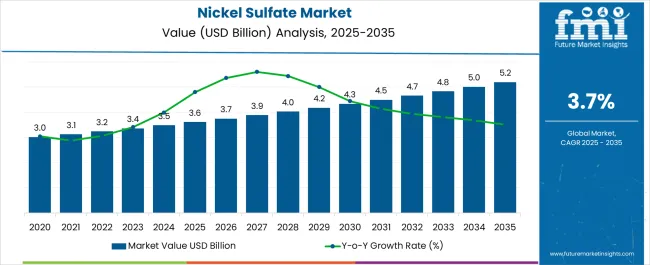
| Metric | Value |
|---|---|
| Nickel Sulfate Market Estimated Value in (2025 E) | USD 3.6 billion |
| Nickel Sulfate Market Forecast Value in (2035 F) | USD 5.2 billion |
| Forecast CAGR (2025 to 2035) | 3.7% |
The Nickel Sulfate market is witnessing strong growth, driven by increasing demand for high-performance materials in electroplating, battery production, and chemical manufacturing. Growth is being fueled by the rapid expansion of electric vehicle adoption, where nickel sulfate is a critical component in cathode production for lithium-ion batteries. The plating and chemical industries are also contributing significantly due to the need for corrosion-resistant coatings and high-purity nickel salts.
Advances in extraction, refining, and purification processes have improved product consistency and reduced operational costs, enhancing market appeal. Growing investments in renewable energy technologies, coupled with global initiatives to reduce carbon emissions, are accelerating the need for nickel-based components in energy storage solutions.
Regulatory emphasis on material quality and environmental compliance is further shaping the market landscape As industries continue to prioritize high-efficiency and sustainable technologies, the Nickel Sulfate market is expected to experience sustained expansion, driven by innovation in battery chemistry, plating solutions, and process optimization.
The nickel sulfate market is segmented by grade, form, application, and geographic regions. By grade, nickel sulfate market is divided into Plating Grade, EN Grade, and High-Purity Grade. In terms of form, nickel sulfate market is classified into Anhydrous, Hexahydrate, and Heptahydrate. Based on application, nickel sulfate market is segmented into Electroplating, Chemicals Industry, Battery, and Others. Regionally, the nickel sulfate industry is classified into North America, Latin America, Western Europe, Eastern Europe, Balkan & Baltic Countries, Russia & Belarus, Central Asia, East Asia, South Asia & Pacific, and the Middle East & Africa.
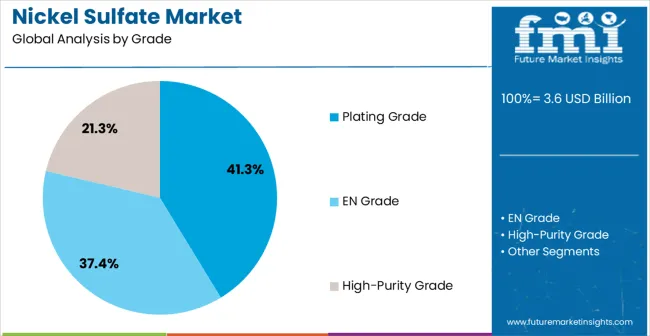
The plating grade segment is projected to hold 41.3% of the market revenue in 2025, establishing it as the leading grade category. This dominance is being driven by its superior purity, which is essential for achieving high-quality surface finishes in electroplating and decorative coatings. Plating grade nickel sulfate enables uniform deposition, excellent adhesion, and corrosion resistance, making it the preferred choice for industrial and commercial applications.
The ability to meet stringent quality and consistency standards has strengthened adoption across automotive, electronics, and jewelry industries. Continuous improvements in production processes, including precise control over nickel content and impurity levels, have enhanced reliability and performance.
As manufacturers seek materials that optimize plating efficiency while reducing defects and operational costs, the plating grade segment is expected to maintain its leading position Its compatibility with diverse plating techniques and robust performance in high-demand applications further reinforces market growth and long-term adoption.
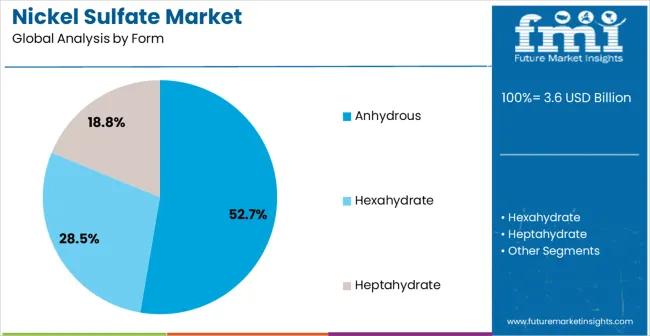
The anhydrous form segment is expected to account for 52.7% of the market revenue in 2025, making it the leading form category. Its growth is being driven by the superior stability and storage advantages offered by anhydrous nickel sulfate compared to hydrated forms. Anhydrous products provide higher concentration per unit volume, improving efficiency in electroplating baths and battery cathode production.
This form also reduces the risk of moisture-related degradation, ensuring consistent quality and performance across industrial processes. The ability to integrate seamlessly into large-scale production lines without additional drying or processing steps enhances operational efficiency.
Increasing adoption in the battery industry, particularly for electric vehicles, and in chemical manufacturing is reinforcing demand With ongoing technological advancements and emphasis on process optimization, the anhydrous form segment is expected to maintain its leading share, supported by performance reliability, process compatibility, and cost efficiency.
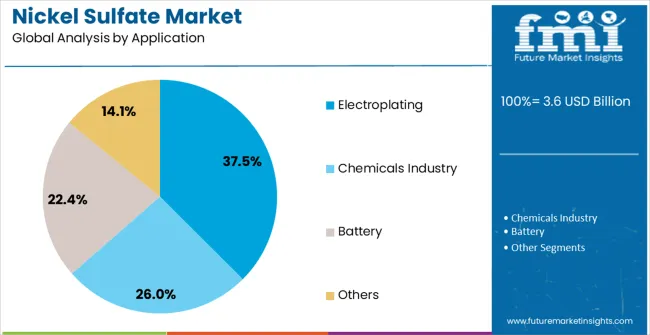
The electroplating application segment is projected to hold 37.5% of the market revenue in 2025, establishing it as the leading application area. Growth in this segment is being driven by the increasing demand for corrosion-resistant and decorative coatings in automotive, electronics, aerospace, and jewelry industries. Nickel sulfate provides high-quality deposition with uniform thickness, excellent adhesion, and enhanced surface finish, which is critical for industrial and commercial plating operations.
The ability to customize bath composition and deposition parameters for specific applications improves operational efficiency and reduces defects. Growing regulatory requirements for coating performance and durability, coupled with rising consumer demand for aesthetically appealing and long-lasting products, are further supporting adoption.
Continuous innovations in electroplating technologies, including environmentally friendly and low-waste processes, are enhancing the appeal of nickel sulfate for plating applications As industries continue to emphasize product quality, durability, and efficiency, the electroplating segment is expected to remain the primary driver of market growth.
Nickel Sulfate is an inorganic compound with the chemical formula NiSO4 (H20)6. It is highly soluble in any aqueous solution and is blue in appearance. Nickel sulfate is one of the primary sources of Ni2+ ion, which is used commercially in electroplating applications. Commercially, there are seven types of Ni (II) salts available in the market which can be used for a variety of applications.
On a commercial scale, nickel sulfate is formulated and synthesized as a by-product in copper refining. Nickel sulfate is also formulated by the dissolution of nickel oxide & nickel metal in sulfuric acid. Within the commercial market, the Nickel sulfate compound is available in different grades, such as plating grade, EN grade and high purity grade.
The plating grade nickel sulfate is generally used in electroplating application technique in which a thin layer or coating of nickel is deposited over the metal surface. Nickel is generally used in electroplating applications as it does not fade on coming in contact with the air. Also, nickel coatings offers better durability, hardness and resistance to corrosion in aggressive environmental conditions.
The EN grade and high purity grades of nickel sulfate find relatively higher adoption in chemicals industry and in formulation of batteries. The use of nickel sulfate in metal surface treatment in battery cathodes will further help in boosting the global demand for end-user industries, such as, automotive, and consumer electronics.
Nickel coating is done on the surface of metals to increase their service life by imparting them with enhanced properties.
| Country | CAGR |
|---|---|
| China | 5.0% |
| India | 4.6% |
| Germany | 4.3% |
| Brazil | 3.9% |
| USA | 3.5% |
| UK | 3.1% |
| Japan | 2.8% |
The Nickel Sulfate Market is expected to register a CAGR of 3.7% during the forecast period, exhibiting varied country level momentum. China leads with the highest CAGR of 5.0%, followed by India at 4.6%. Developed markets such as Germany, France, and the UK continue to expand steadily, while the USA is likely to grow at consistent rates. Japan posts the lowest CAGR at 2.8%, yet still underscores a broadly positive trajectory for the global Nickel Sulfate Market. In 2024, Germany held a dominant revenue in the Western Europe market and is expected to grow with a CAGR of 4.3%. The USA Nickel Sulfate Market is estimated to be valued at USD 1.3 billion in 2025 and is anticipated to reach a valuation of USD 1.3 billion by 2035. Sales are projected to rise at a CAGR of 0.0% over the forecast period between 2025 and 2035. While Japan and South Korea markets are estimated to be valued at USD 168.1 million and USD 122.7 million respectively in 2025.
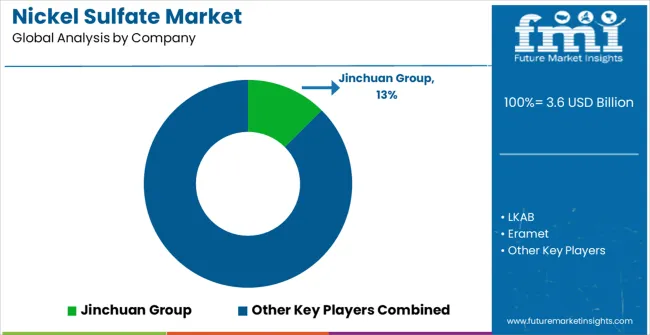
| Item | Value |
|---|---|
| Quantitative Units | USD 3.6 Billion |
| Grade | Plating Grade, EN Grade, and High-Purity Grade |
| Form | Anhydrous, Hexahydrate, and Heptahydrate |
| Application | Electroplating, Chemicals Industry, Battery, and Others |
| Regions Covered | North America, Europe, Asia-Pacific, Latin America, Middle East & Africa |
| Country Covered | United States, Canada, Germany, France, United Kingdom, China, Japan, India, Brazil, South Africa |
| Key Companies Profiled | Jinchuan Group, LKAB, Eramet, Anglo American, BHP Billiton, Sumitomo Metal Mining, Vale, Sherritt International, Umicore, Glencore, Boliden, Norilsk Nickel, Outokumpu, Polymetal International, and Nornickel |
The global nickel sulfate market is estimated to be valued at USD 3.6 billion in 2025.
The market size for the nickel sulfate market is projected to reach USD 5.2 billion by 2035.
The nickel sulfate market is expected to grow at a 3.7% CAGR between 2025 and 2035.
The key product types in nickel sulfate market are plating grade, en grade and high-purity grade.
In terms of form, anhydrous segment to command 52.7% share in the nickel sulfate market in 2025.






Our Research Products

The "Full Research Suite" delivers actionable market intel, deep dives on markets or technologies, so clients act faster, cut risk, and unlock growth.

The Leaderboard benchmarks and ranks top vendors, classifying them as Established Leaders, Leading Challengers, or Disruptors & Challengers.

Locates where complements amplify value and substitutes erode it, forecasting net impact by horizon

We deliver granular, decision-grade intel: market sizing, 5-year forecasts, pricing, adoption, usage, revenue, and operational KPIs—plus competitor tracking, regulation, and value chains—across 60 countries broadly.

Spot the shifts before they hit your P&L. We track inflection points, adoption curves, pricing moves, and ecosystem plays to show where demand is heading, why it is changing, and what to do next across high-growth markets and disruptive tech

Real-time reads of user behavior. We track shifting priorities, perceptions of today’s and next-gen services, and provider experience, then pace how fast tech moves from trial to adoption, blending buyer, consumer, and channel inputs with social signals (#WhySwitch, #UX).

Partner with our analyst team to build a custom report designed around your business priorities. From analysing market trends to assessing competitors or crafting bespoke datasets, we tailor insights to your needs.
Supplier Intelligence
Discovery & Profiling
Capacity & Footprint
Performance & Risk
Compliance & Governance
Commercial Readiness
Who Supplies Whom
Scorecards & Shortlists
Playbooks & Docs
Category Intelligence
Definition & Scope
Demand & Use Cases
Cost Drivers
Market Structure
Supply Chain Map
Trade & Policy
Operating Norms
Deliverables
Buyer Intelligence
Account Basics
Spend & Scope
Procurement Model
Vendor Requirements
Terms & Policies
Entry Strategy
Pain Points & Triggers
Outputs
Pricing Analysis
Benchmarks
Trends
Should-Cost
Indexation
Landed Cost
Commercial Terms
Deliverables
Brand Analysis
Positioning & Value Prop
Share & Presence
Customer Evidence
Go-to-Market
Digital & Reputation
Compliance & Trust
KPIs & Gaps
Outputs
Full Research Suite comprises of:
Market outlook & trends analysis
Interviews & case studies
Strategic recommendations
Vendor profiles & capabilities analysis
5-year forecasts
8 regions and 60+ country-level data splits
Market segment data splits
12 months of continuous data updates
DELIVERED AS:
PDF EXCEL ONLINE
Nickel Mining Market Size and Share Forecast Outlook 2025 to 2035
Nickel Superalloy Market Size and Share Forecast Outlook 2025 to 2035
Nickel Niobium Market Size and Share Forecast Outlook 2025 to 2035
Nickel Carbonate Market Size and Share Forecast Outlook 2025 to 2035
Nickel Acetate Market Size and Share Forecast Outlook 2025 to 2035
Nickel Cobalt Manganese (NCM) Market Trend Analysis Based on Product, End-Use, and Region 2025 to 2035
Nickel Cobalt Aluminium Market Trend Analysis Based on Purity, End Use, and Region 2025 to 2035
Nickel Nitrate Hexahydrate Market
Nickel Alloy Market
Aluminum-Nickel Catalyst Market Size and Share Forecast Outlook 2025 to 2035
Sulfate-Free Shampoos Market Analysis - Size, Share, and Forecast Outlook 2025 to 2035
Persulfates Market Size and Share Forecast Outlook 2025 to 2035
Crude Sulfate Turpentine Market Analysis by Product Type, Source, Processing Method, Application, and Region through 2035
Ferric Sulfate Market Growth - Trends & Forecast 2025 to 2035
Barium Sulfate Market Analysis - Size, Share & Forecast 2025 to 2035
Ferric Sulfate & Polyferric Sulfate Market 2024-2034
Calcium Sulfate Market Size and Share Forecast Outlook 2025 to 2035
Diethyl Sulfate Market Size and Share Forecast Outlook 2025 to 2035
Ferrous Sulfate Market - Size, Share & Forecast 2025 to 2035
Ammonium Sulfate Food Grade Market Report - Industry Insights 2025 to 2035

Thank you!
You will receive an email from our Business Development Manager. Please be sure to check your SPAM/JUNK folder too.
Chat With
MaRIA